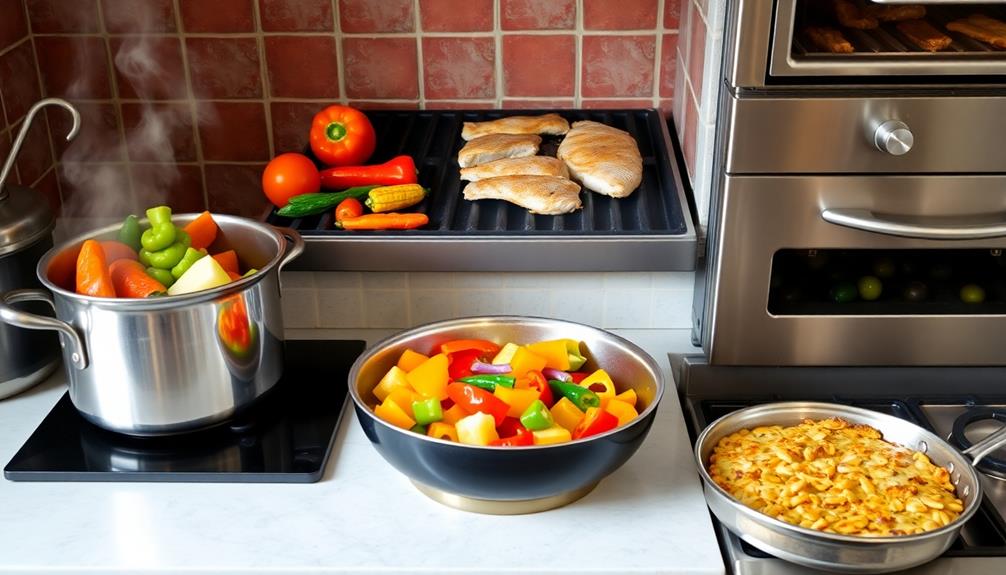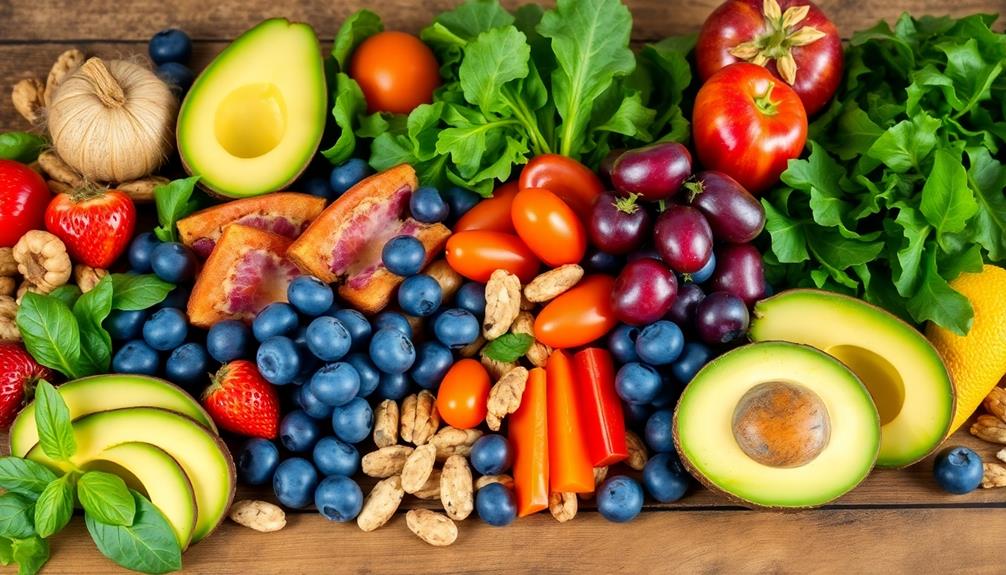Cooking methods really impact the nutritional value of your food, and it's exciting to see how! Here's a quick look at how different methods affect your meals:
- Steaming keeps up to 90% of nutrients.
- Boiling can lose over 50% of vitamin C.
- Microwaving is quick and better at retaining nutrients than boiling.
- Grilling and frying can cause significant losses in important vitamins and omega-3s.
Choosing the right method can make your meals not just tasty but also super nutritious! Keep exploring to find out more helpful tips for cooking delicious, healthy meals!
Key Takeaways
- Steaming preserves up to 90% of nutrients in vegetables, making it the best cooking method for nutrient retention.
- Boiling can lead to over 50% loss of vitamin C in vegetables, significantly impacting their nutritional value.
- Microwaving retains more nutrients than boiling, with only a 20-30% loss of vitamin C in green vegetables.
- High-heat cooking methods like frying can degrade omega-3 fatty acids by 70-85%, reducing the nutritional quality of the food.
- Cooking can enhance nutrient availability, such as increasing lycopene in tomatoes by 164% when cooked, improving their health benefits.
Nutrient Changes During Cooking

When you cook your vegetables, the method you choose can greatly impact their nutritional value. Did you know that boiling can cause over 50% loss of vitamin C content? That's a lot! Instead, try steaming your veggies, which can preserve up to 90% of their nutrients. Isn't that amazing?
For instance, incorporating fresh ingredients like those in a Nettle and Potato Soup can highlight the importance of preserving nutrients while enhancing flavor.
Microwaving is another great option! It often results in higher nutrient retention, with only 20-30% loss of vitamin C in green vegetables.
Now, let's talk about high-heat cooking methods, like grilling and frying. While they can be delicious, they might lead to harmful compounds forming and degrade important vitamins, especially B vitamins, with losses reaching up to 40%.
To keep your veggies at their nutritional best, remember these tips:
- Use short cooking times at lower temperatures.
- Opt for sautéing or stir-frying, which helps retain nutrients.
- Minimize water to protect those precious water-soluble vitamins.
Overview of Cooking Methods

Cooking methods play an essential role in how our meals turn out, affecting both flavor and nutrition. Different cooking methods can change how many nutrients your food retains. For instance, water-based cooking, like boiling, can lead to over 50% loss of vitamin C in vegetables!
On the bright side, steaming helps keep up to 90% of those nutrients. Additionally, methods like sautéing can enhance the flavors of dishes such as Mushroom Masala, allowing the spices to fully develop while preserving their nutritional value.
Now, let's talk about high-heat techniques, such as grilling and frying. While they can make food delicious, these methods can also lead to a loss of heat-sensitive vitamins. Grilling, in particular, might create harmful compounds, so be careful!
Microwaving is a super convenient method, and it generally holds more nutrients than boiling, losing only about 20-30% of vitamin C in green veggies.
Plus, sautéing and stir-frying are fantastic for enhancing the absorption of fat-soluble vitamins and antioxidants, thanks to their short cooking times and the use of minimal oil.
Water-Based Cooking Techniques

Although water-based cooking techniques are often convenient, they can greatly impact the nutrient content of your food. For instance, certain cooking methods can also influence the flavors and textures of dishes, such as the tender and rich profile of Red-Braised Pork Belly.
Let's explore how these methods work and what they mean for your meals!
- Boiling: This simple method can cause significant nutrient loss, especially for vitamins. Did you know boiling veggies can zap over 50% of vitamin C? That's a lot of goodness going down the drain!
- Steaming: Here's a winner! Steaming is one of the best ways to keep those precious vitamins. You'll only lose about 9-15% of water-soluble vitamins, making it perfect for colorful veggies.
- Blanching: This quick method involves plunging food into boiling water and then cooling it down. It stops enzyme activity and helps keep colors bright with minimal nutrient loss.
- Poaching: This gentle technique cooks food at lower temperatures, keeping more vitamins intact compared to boiling. It's a great way to enjoy fish or eggs without losing their goodness.
- Simmering: While simmering can lead to a 60% loss of B vitamins in meat, don't forget to enjoy those tasty cooking juices to retain some nutrients!
High-Heat Cooking Methods
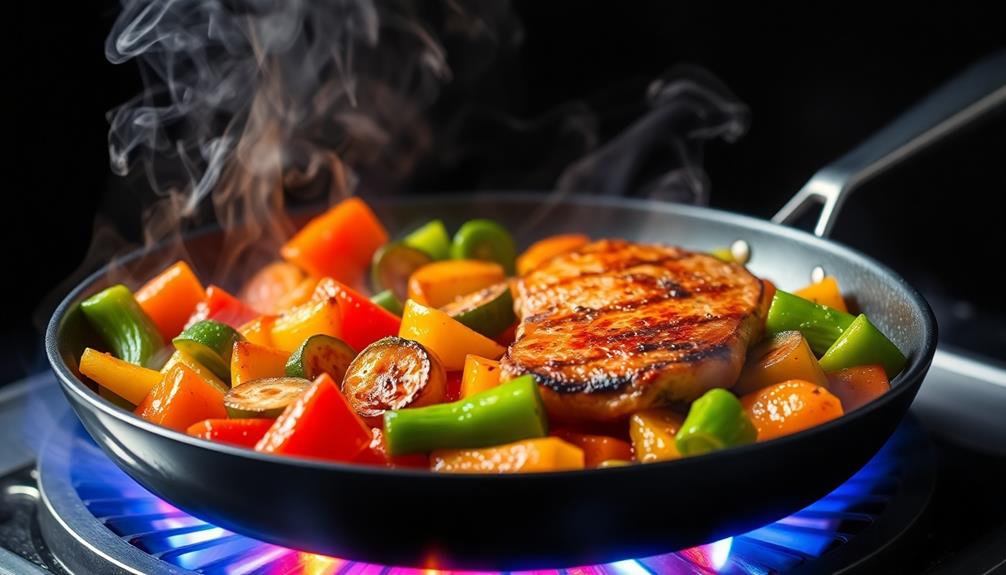
High-heat cooking methods like roasting, grilling, and frying can transform your meals with rich flavors and appealing textures, but they come with a trade-off. While these techniques can make your food delicious, they can also lead to vitamin losses that affect the nutritional value of what you eat.
For instance, traditional Brazilian dishes like Caldeirada showcase how stewing can retain nutrients while delivering robust flavors.
Here are some important points to take into account:
- Roasting at high temperatures can damage vitamin C and B vitamins, making your veggies less nutritious.
- Grilling can cause a loss of up to 40% of B vitamins and minerals because juices drip away.
- Frying can degrade omega-3 fatty acids in fatty fish by 70-85%, plus it introduces harmful compounds like acrylamide, especially in starchy foods.
Also, high-heat cooking creates chemical reactions, like the Maillard reaction, which can produce harmful compounds linked to health risks.
For example, grilled meats can contain substances equivalent to 120 cigarettes per serving!
To keep your meals both tasty and nutritious, try to enjoy these high-heat cooking methods in moderation. Balance them with other cooking styles that preserve nutrients, and your family will thank you for the delicious, health-conscious meals!
Microwaving for Nutritional Retention
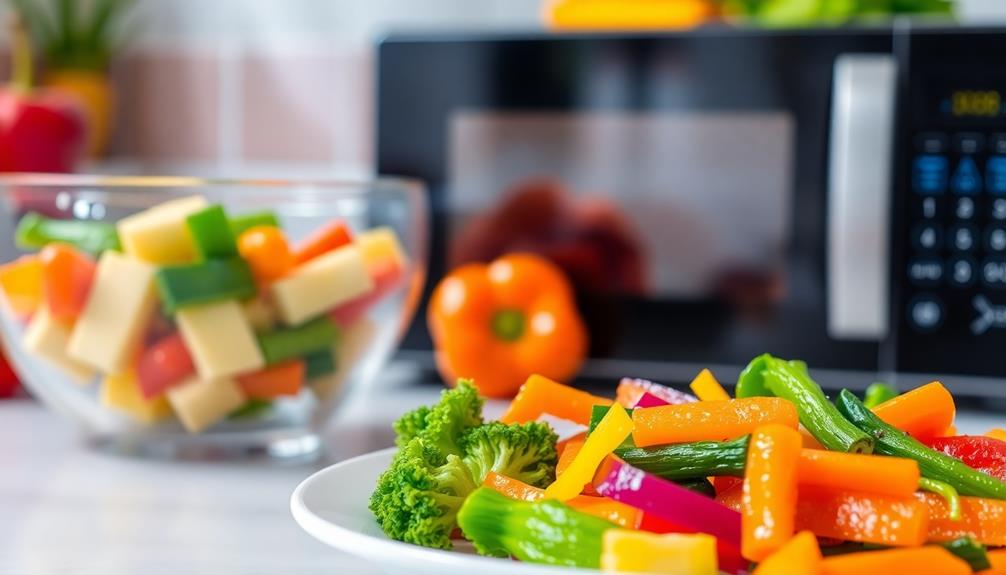
Microwaving stands out as a remarkably efficient cooking method that helps preserve the nutritional value of your food. When you use this technique, you're not just saving time; you're also keeping more vitamins in your veggies!
This method is particularly beneficial for cooking Asian Cuisine dishes, where vibrant vegetables are essential. Studies show that microwaving can lead to only a 20-30% loss of vitamin C in green vegetables, which is much better than many other cooking methods.
Here are some fun facts about microwaving for nutrient retention:
- It retains up to 90% of certain vitamins!
- Short cooking times mean less nutrient loss, especially for heat-sensitive vitamins like B vitamins and vitamin C.
- Unlike boiling, you use minimal or no water, so nutrients stay in your food, not in the water!
- Microwaving is great for garlic and mushrooms, keeping their antioxidant activity high.
Raw vs. Cooked Nutritional Value

When you think about raw versus cooked foods, it's exciting to discover how cooking can change the nutrients in what you eat!
Cooking can make proteins and antioxidants more available, helping your body soak up the good stuff better. For example, certain cooking methods can enhance the flavors and textures of ingredients like Hiyashi Chuka (Cold Ramen), making them more enjoyable while also impacting their nutritional profiles. Cooking not only transforms the way food tastes but also plays a vital role in unlocking nutrients that are otherwise harder for your body to access. When enjoying dishes like Hiyashi Chuka, using chopsticks and Asian culinary traditions can deepen your appreciation for both the art and health benefits of the meal. By blending traditional preparation techniques with modern nutritional insights, meals can be both delicious and nourishing.
However, raw foods keep certain enzymes and nutrients that cooking might take away, so it's fun to enjoy a mix of both for the best health benefits!
Nutrient Bioavailability Differences
How do cooking methods impact the nutritional value of your food? When you cook, you change how your body can use the nutrients, known as nutrient bioavailability. Some cooking methods can make nutrients easier to absorb.
For example, cooking tomatoes boosts lycopene by 164%! Similarly, cooked carrots give you about 25% more beta-carotene than raw ones. Isn't that amazing? Traditional Indonesian dishes like Kue Putu also showcase how steaming can enhance flavors while preserving nutrients.
While raw foods hold onto heat-sensitive vitamins like vitamin C, cooking can enhance the digestibility of proteins. Cooked eggs have 180% more digestible protein than raw ones! Plus, steaming can keep more vitamins than boiling, making it a healthier cooking option.
Here's a quick look at how cooking affects nutrients:
- Lycopene in tomatoes: Up by 164% when cooked!
- Beta-carotene in carrots: 25% more in cooked carrots!
- Protein in eggs: 180% more digestible when cooked!
- Antioxidants in broccoli: Better absorbed when cooked!
Enzyme Preservation in Raw
Choosing between raw and cooked foods can greatly impact the enzymes in your meals. Raw foods often retain special enzymes that help with digestion and boost your overall health, making dishes like Agnolotti even more beneficial when prepared with fresh ingredients.
When you cook, some cooking methods might destroy these enzymes, affecting the nutritional value of your meals. Here's what you might want to know about enzyme preservation:
- Raw veggies can pack a higher punch of enzymes that support digestion.
- Some cooking methods, like steaming, keep more vitamins intact compared to boiling or frying.
- Heat-sensitive vitamins, like vitamin C and B vitamins, can shrink during cooking, lowering nutritional value.
Cooking Meat and Fish Healthily

Cooking meat and fish healthily involves selecting the right methods to maximize their nutritional benefits. You'll want to use cooking methods that keep their delicious flavors while also preserving their nutritional value.
Steaming and poaching are fantastic choices! These methods help maintain the omega-3 fatty acids in fish, which are super important for your health. Additionally, incorporating dishes like Yetimatim Fitfit can enhance your meals with nutritious ingredients like tomatoes and spices that complement the main protein.
Here are some healthier alternatives to evaluate:
- Grilling: Adds a smoky flavor without excess fats.
- Baking: Keeps moisture in and is easy to do!
- Steaming: Preserves nutrients and is quick.
Avoid high-heat cooking methods like frying, as they can reduce protein retention and destroy up to 85% of those precious omega-3 fatty acids.
Cooking meat at lower temperatures not only helps keep it juicy but also protects essential nutrients from being lost.
Safe Cooking Practices
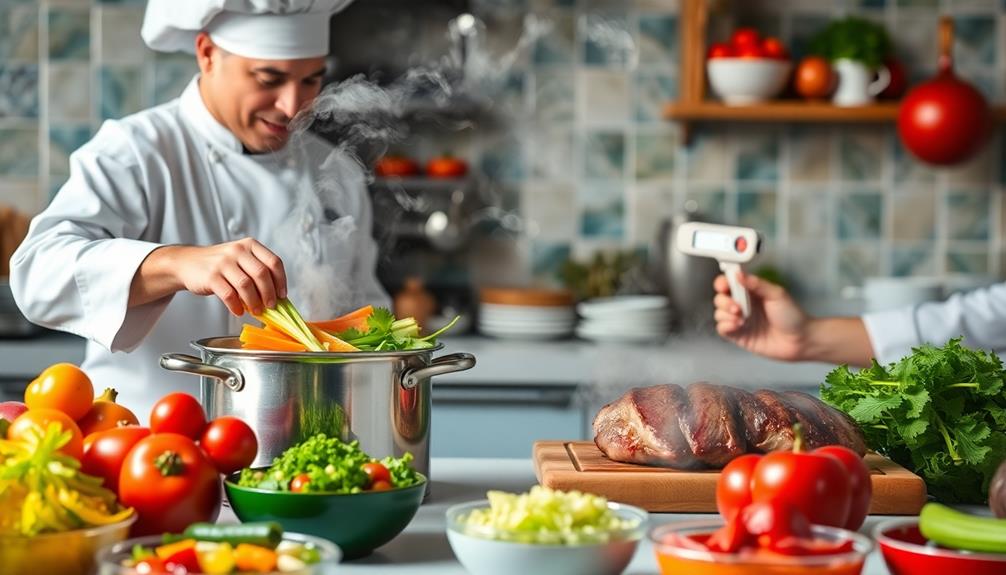
When you cook meat, it's super important to hit the right temperatures to keep your family safe and healthy!
Utilizing leftover turkey from Thanksgiving feasts in dishes like Turkey Sandwiches can be a great way to guarantee you're cooking food to the right heat, like 165°F for poultry.
Plus, by handling food safely and keeping things clean, you can whip up delicious meals without any worries!
Essential Meat Temperatures
Making sure that meat reaches the proper internal temperature is vital for your health and safety. Cooking methods can impact not just flavor, but also the nutritional value of your meals.
It's important to know the safe cooking temperatures to avoid foodborne illnesses and keep your family safe.
Here are some key temperatures to remember:
- Poultry (including ground poultry): 165°F (74°C)
- Ground meats (like beef and pork): 160°F (71°C)
- Whole cuts of beef, pork, lamb, and veal: 145°F (63°C) followed by a 3-minute rest
Using a meat thermometer helps make sure you hit these internal temperatures, reducing the risk of harmful bacteria like Salmonella and E. coli.
Plus, cooking meat to these safe temperatures not only protects you but also helps retain its overall quality and nutritional value.
Safe Food Handling
Safe food handling is essential for preventing foodborne illnesses and ensuring your meals are both delicious and nutritious. To keep your family safe while enjoying tasty dishes, follow these simple guidelines:
- Cook to the Right Temperatures: Always use a meat thermometer! Cook poultry to 165°F (74°C) and whole cuts of beef, pork, lamb, and veal to 145°F (63°C). This helps eliminate harmful bacteria.
- Prevent Cross-Contamination: Use separate cutting boards for raw meats and other foods. Make sure to wash your hands and surfaces after handling raw ingredients. This keeps your meals safe and healthy!
- Thaw Safely: Always thaw frozen foods in the refrigerator or in cold water, not at room temperature. This prevents bacteria from growing and keeps your food safe.
- Clean Your Cooking Equipment: Regularly clean your utensils and cooking equipment, especially those that touch raw meat. A clean kitchen is a happy kitchen!
Impact of Cooking on Vitamins

Cooking methods play an essential role in determining the vitamin content of your meals. You might be surprised to learn how different techniques can affect vitamin retention, especially for water-soluble vitamins like B vitamins and vitamin C. High temperatures and longer cooking times can lead to significant nutrient loss.
Here's how some popular methods stack up:
- Steaming can preserve up to 90% of nutrients.
- Microwaving generally results in a 20-30% loss of vitamin C, which is much better than boiling.
- Sautéing and stir-frying keep those fat-soluble vitamins intact!
When you choose to boil vegetables, you could lose over 50% of vitamin C! That's a big hit to the nutrition you want in your meals.
Roasting and grilling can also damage those delicate vitamins, so keep an eye on cooking time and temperature. Quick cooking methods like steaming and sautéing aren't just fun but smart ways to keep your food vibrant and healthy.
Best Practices for Nutrient Preservation

When you want to maximize the nutritional value of your meals, adopting best practices for nutrient preservation becomes key. Here are some fun and easy ways to keep your vegetables bursting with goodness!
- Steaming: This method can preserve up to 90% of nutrients. That's way better than boiling, where nutrients can escape into the water!
- Microwaving: Quick and easy, this technique keeps more antioxidants and vitamins intact, losing only 20-30% of vitamin C. Perfect for busy nights!
- Waterless cooking: Using minimal water can retain up to 93% of nutrients. No more worrying about vitamins leaching away!
- Stir-frying: By cooking at high temperatures with just a little oil, you keep both flavor and nutrition. It's fast and tasty!
- Short cooking times: Methods like poaching and sous-vide help maintain the overall nutrient content. Less time cooking means more nutrients for you!
Frequently Asked Questions
How Do Cooking Methods Affect Nutritional Value?
Cooking methods affect nutritional value by determining how much of the food's nutrients you retain. When you choose steaming or microwaving, you preserve more vitamins, while boiling or frying can lead to significant nutrient loss.
Does the Nutritional Value of Food Change When Cooked?
When you cook food, it transforms like a butterfly emerging from a chrysalis, but not all changes are beneficial. Yes, cooking alters nutritional value, sometimes enhancing nutrients but often leading to significant losses, especially in water-soluble vitamins.
How Do Storage Methods Affect the Nutritional Value of Food?
Storage methods affect food's nutritional value considerably. If you store perishables in airtight containers and refrigerate promptly, you'll retain more vitamins. Remember, longer storage times can lead to nutrient loss, especially for sensitive vitamins.
How Does Processing Affect the Nutritional Value of Foods?
Processing affects nutritional value by altering the food's natural state. You might lose vitamins and minerals during refining or preserve them through methods like freezing. It's essential to choose less processed options for better nutrition.
Conclusion
In the grand feast of life, how you cook can make a big difference in your meals! By choosing the right methods, like steaming or grilling, you can keep those vitamins dancing in your dishes. Remember, every meal is a chance to nourish your family and create tasty memories together. So, get cooking with joy, and let those healthy flavors shine! Happy cooking, and may your table always be filled with love and laughter!

